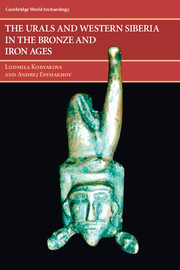Book contents
- Frontmatter
- Contents
- List of Plates, Figures, and Tables
- Foreword, by Philip L. Kohl
- Preface
- Introduction
- PART ONE THE BRONZE AGE: THE RISE OF ECONOMIC AND CULTURAL COMPLEXITY
- 1 The Development of Bronze Metallurgy
- 2 The Achievements and Collisions of the Early and Middle Bronze Age
- 3 Stabilization, Colonization, and Expansion in the Late Bronze Age
- 4 On the Eve of a New Epoch: Final Bronze Age
- PART TWO THE IRON AGE – FORMING EURASIAN INTERACTIONS
- Notes
- References
- Index
4 - On the Eve of a New Epoch: Final Bronze Age
from PART ONE - THE BRONZE AGE: THE RISE OF ECONOMIC AND CULTURAL COMPLEXITY
Published online by Cambridge University Press: 03 February 2010
- Frontmatter
- Contents
- List of Plates, Figures, and Tables
- Foreword, by Philip L. Kohl
- Preface
- Introduction
- PART ONE THE BRONZE AGE: THE RISE OF ECONOMIC AND CULTURAL COMPLEXITY
- 1 The Development of Bronze Metallurgy
- 2 The Achievements and Collisions of the Early and Middle Bronze Age
- 3 Stabilization, Colonization, and Expansion in the Late Bronze Age
- 4 On the Eve of a New Epoch: Final Bronze Age
- PART TWO THE IRON AGE – FORMING EURASIAN INTERACTIONS
- Notes
- References
- Index
Summary
Around the fourteenth/thirteenth centuries bc, the societies of the Andronovo-Srubnaya area were gradually transformed, which, however, cannot be described only in term of decline or collapse. Some societies became more homogeneous and simpler. The others changed their strategies toward the adaptation to the new environmental (natural, cultural, and social) conditions. In all cases, basic cultural traditions that were stable during the previous centuries changed their appearance as evidenced by the structural regrouping within the whole area under study. Archaeologically, this has found reflection in different types of material culture.
THE SARGARY CULTURE
The end of the Bronze Age in the Eurasian steppes is marked by the formation of the vast cultural occurrence which is known under general term “horizon of cultures of the Valikovaya pottery tradition” (Chernykh 1983, 1992). This cultural occurrence occupied practically of the all steppe and forest-steppe from Altai to eastern Europe. The most western part is constituted by cultures of the Low Danube, eastern Carpathians, and northern coast of the Black Sea. In the east, this formation comprised the cultures of the Don-Volga-Ural area (late Srubnaya culture), southern Urals and Trans-Urals, and Kazakhstan (Sargary, Trushnikovo, Dandybai-Begazy, Amirabad). Their common marker is the poorly ornamented flat-bottomed pottery with clay rollers stuck around the shoulder or neck. There also are some other similarities in metal, economic structure, and funeral ritual.
In the steppe zone, there are a few sites of this period investigated by large-scale excavations. Meanwhile, the number of surveyed site is quite impressive.
- Type
- Chapter
- Information
- The Urals and Western Siberia in the Bronze and Iron Ages , pp. 161 - 184Publisher: Cambridge University PressPrint publication year: 2007



